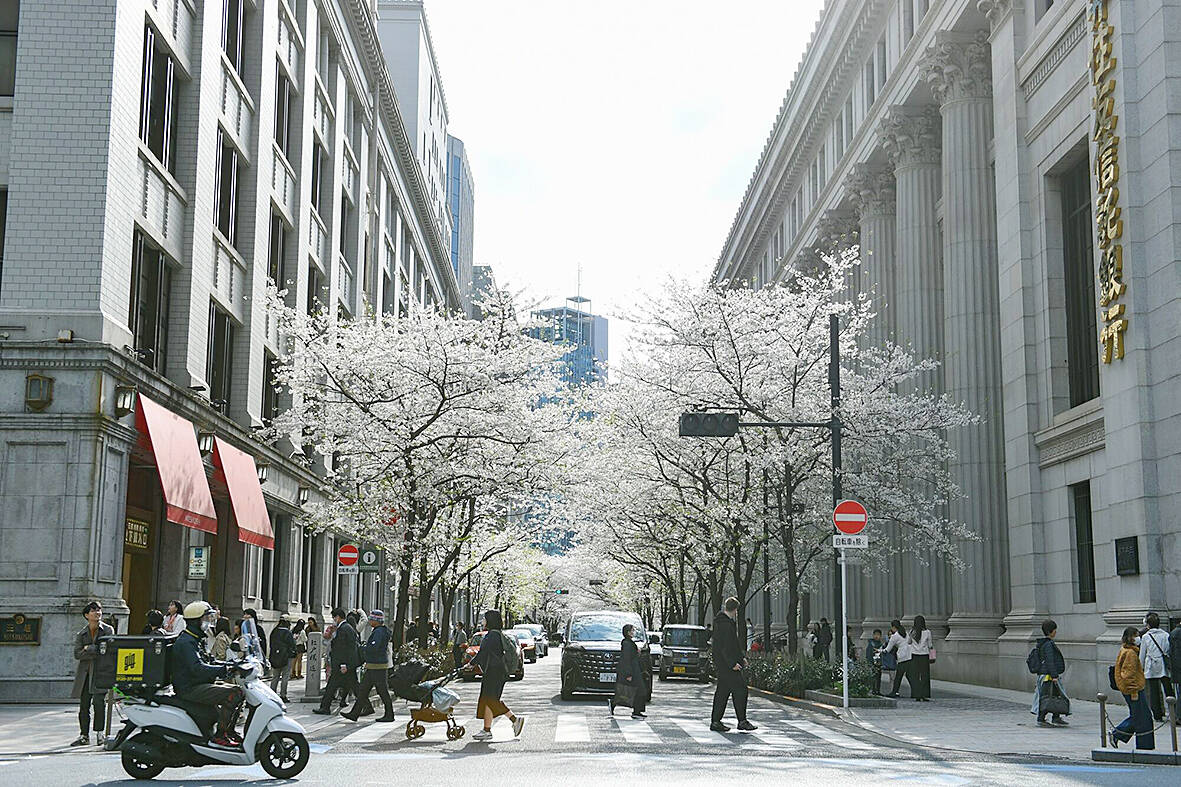Japan’s famed cherry trees are getting old, but a new AI tool that assesses photos of the delicate pink and white flowers could help preserve them for future generations.
The “sakura” season is feverishly anticipated by locals and visitors alike, with the profusion of the stunning blossoms marking the start of spring.
But many of the trees are reaching 70 to 80 years old, well beyond their prime blooming age.

Photo: AFP
This means increasing costs to tend to the trees and maintain popular flowering spots. To help authorities identify ailing specimens, brewing giant Kirin developed a tool called Sakura AI Camera.
It tells users the condition and the age of the trees based on photos they take with their smartphones and upload them to a Web site.
A five-point scale — only available in Japanese for now — ranges from “very healthy” to “worrying.”

Photo: AFP
A tree with healthy flowers blooming densely all the way to the tips of the branches gets top marks.
The artificial intelligence tool has been trained using 5,000 images of cherry trees with the help of experts.
The photos are then mapped on the Sakura AI Camera Web site with details such as tree condition and location.

Photo: AFP
“We heard that the preservation of sakura requires manpower and money and that it’s difficult to gather information,” said Risa Shioda from Kirin.
“I think we can contribute by making it easier to plan for conservation,” she said.
About 20,000 photos have been collected since the launch last month, with the data available online for free for local authorities.

Photo: Bloomberg
WORTH A MILLION
According to Tokyo’s Meguro Ward, famous for its riverbanks lined with cherry trees, replanting a new one costs around one million yen (US$6,800). Hiroyuki Wada of the Japan Tree Doctors Association, who inspects cherry trees in major spots in Tokyo, helped supervise the AI tool.
He said he hopes that it will help experts study the environmental reasons behind the degradation of some of the trees he sees.
In part, he blames climate change. “I’m very worried. Changes in the environment are usually gradual, but now it’s visible,” he said.
“There are impacts from the heat, and of course the lack of rainfall,” he said.
“The age of the trees naturally makes the situation more serious,” he added.
Japan’s weather agency said in January that last year was the hottest since records began, like other nations.
Kirin began donating some of its profits for the preservation of cherry trees last year, as a way to “pay back” to the communities.
Alcohol, especially beer, is one of the drinks enjoyed at hanami flower-viewing parties beneath the trees, Shioda said.
Cherry blossoms symbolise the fragility of life in Japanese culture as full blooms only last about a week before the petals start falling off trees.
The season is also considered one of change as it marks the start of the new business year, with many university graduates starting their first full-time jobs and older colleagues shifting to new positions.

In the March 9 edition of the Taipei Times a piece by Ninon Godefroy ran with the headine “The quiet, gentle rhythm of Taiwan.” It started with the line “Taiwan is a small, humble place. There is no Eiffel Tower, no pyramids — no singular attraction that draws the world’s attention.” I laughed out loud at that. This was out of no disrespect for the author or the piece, which made some interesting analogies and good points about how both Din Tai Fung’s and Taiwan Semiconductor Manufacturing Co’s (TSMC, 台積電) meticulous attention to detail and quality are not quite up to

April 21 to April 27 Hsieh Er’s (謝娥) political fortunes were rising fast after she got out of jail and joined the Chinese Nationalist Party (KMT) in December 1945. Not only did she hold key positions in various committees, she was elected the only woman on the Taipei City Council and headed to Nanjing in 1946 as the sole Taiwanese female representative to the National Constituent Assembly. With the support of first lady Soong May-ling (宋美齡), she started the Taipei Women’s Association and Taiwan Provincial Women’s Association, where she

It is one of the more remarkable facts of Taiwan history that it was never occupied or claimed by any of the numerous kingdoms of southern China — Han or otherwise — that lay just across the water from it. None of their brilliant ministers ever discovered that Taiwan was a “core interest” of the state whose annexation was “inevitable.” As Paul Kua notes in an excellent monograph laying out how the Portuguese gave Taiwan the name “Formosa,” the first Europeans to express an interest in occupying Taiwan were the Spanish. Tonio Andrade in his seminal work, How Taiwan Became Chinese,

Mongolian influencer Anudari Daarya looks effortlessly glamorous and carefree in her social media posts — but the classically trained pianist’s road to acceptance as a transgender artist has been anything but easy. She is one of a growing number of Mongolian LGBTQ youth challenging stereotypes and fighting for acceptance through media representation in the socially conservative country. LGBTQ Mongolians often hide their identities from their employers and colleagues for fear of discrimination, with a survey by the non-profit LGBT Centre Mongolia showing that only 20 percent of people felt comfortable coming out at work. Daarya, 25, said she has faced discrimination since she